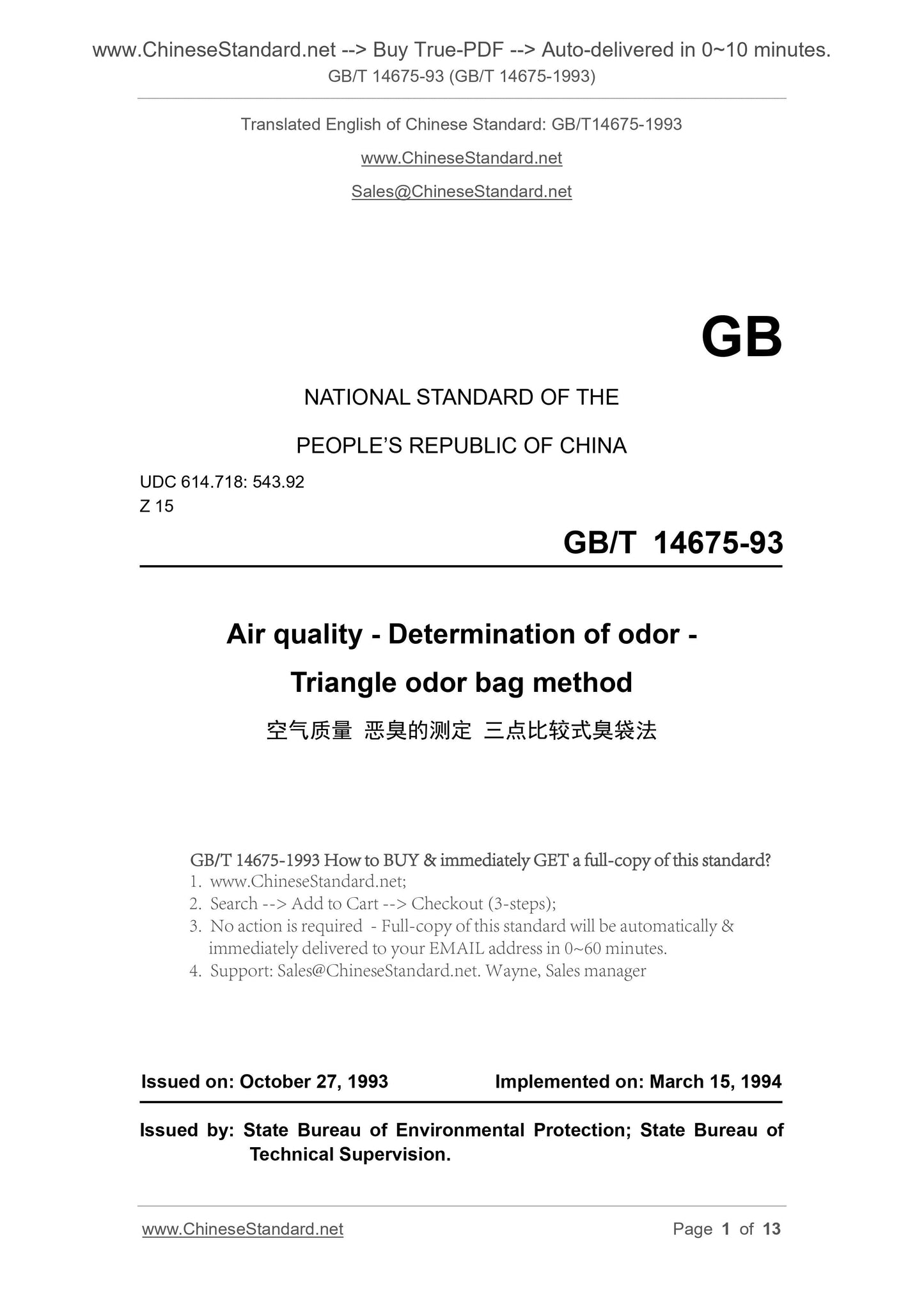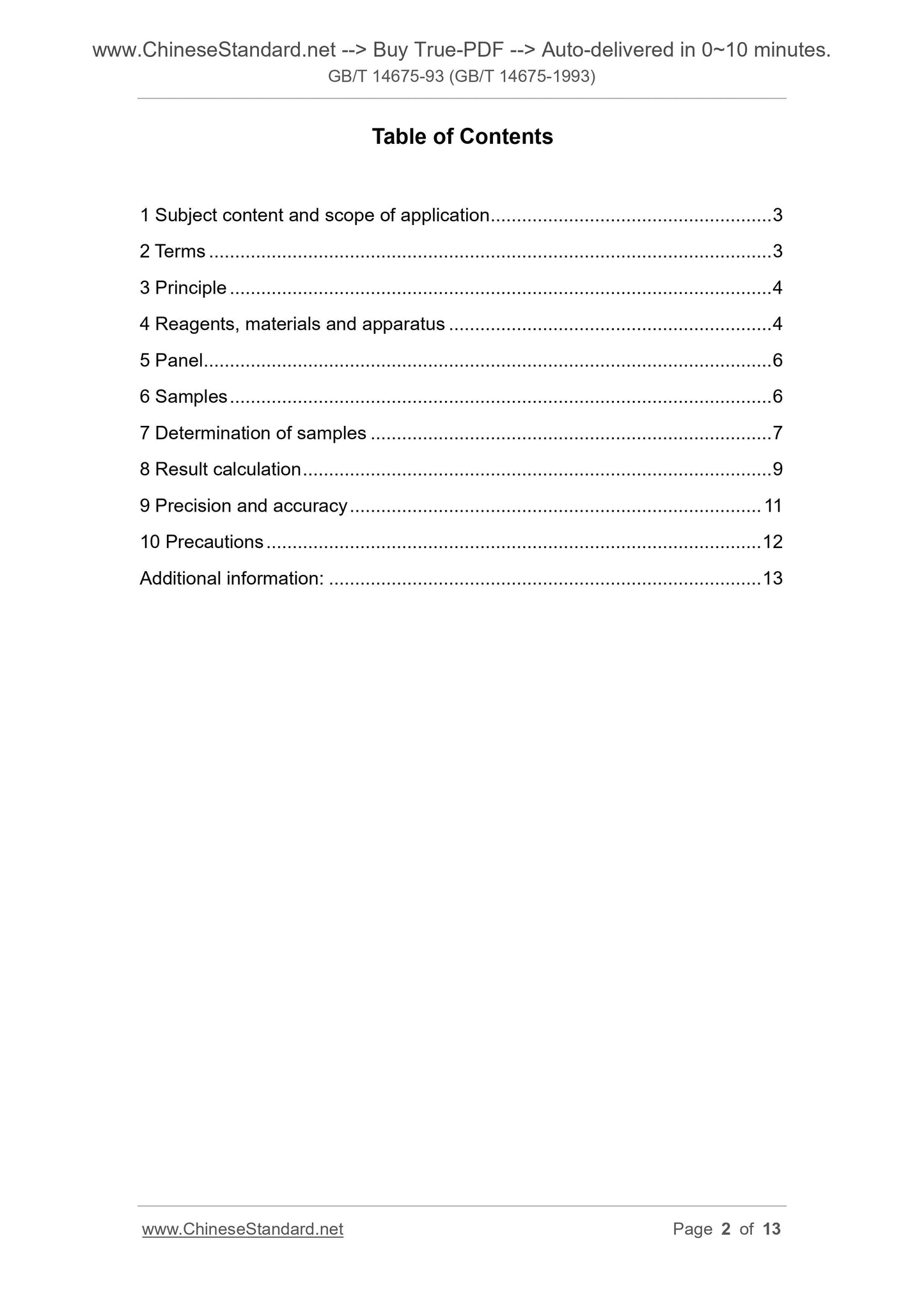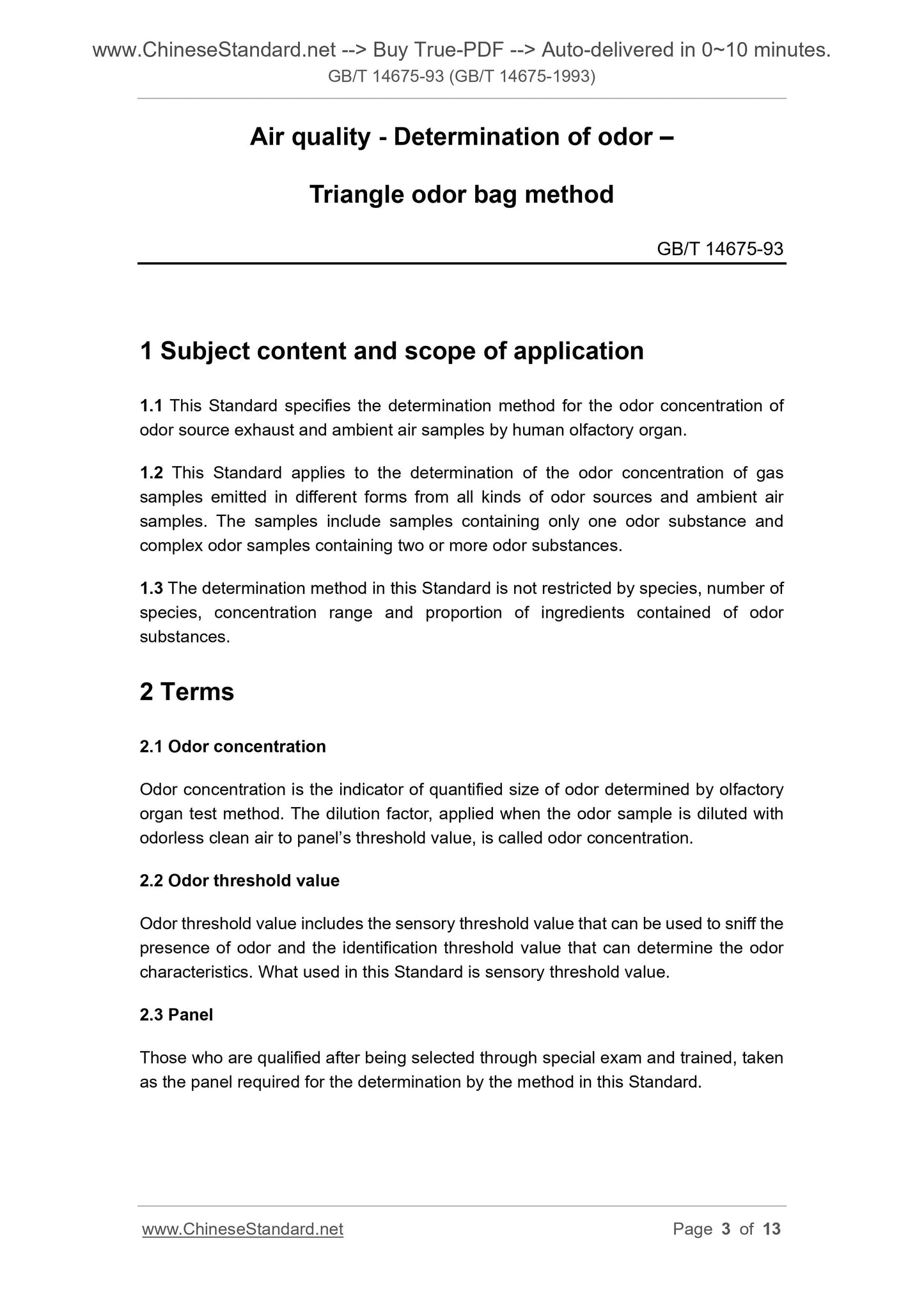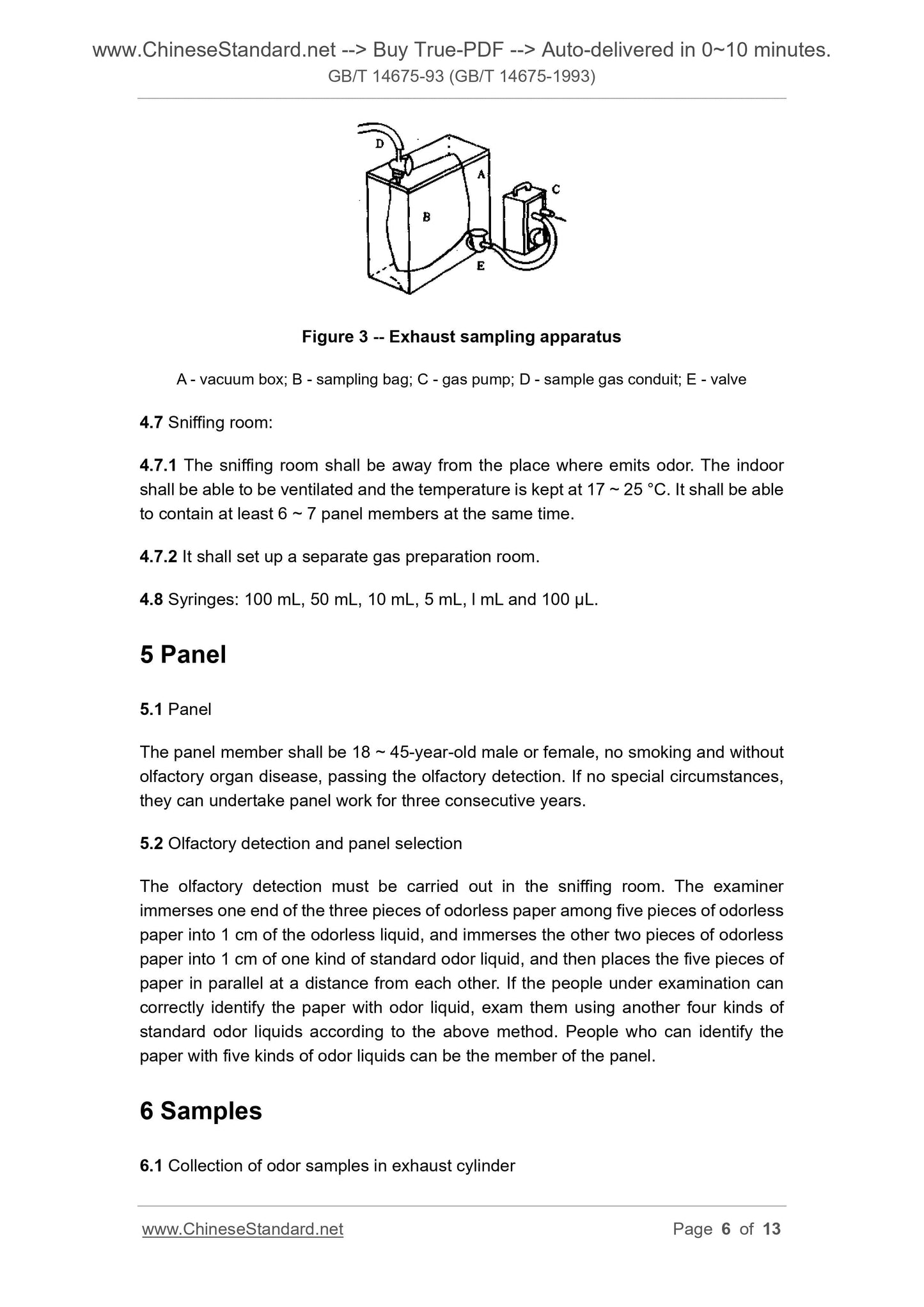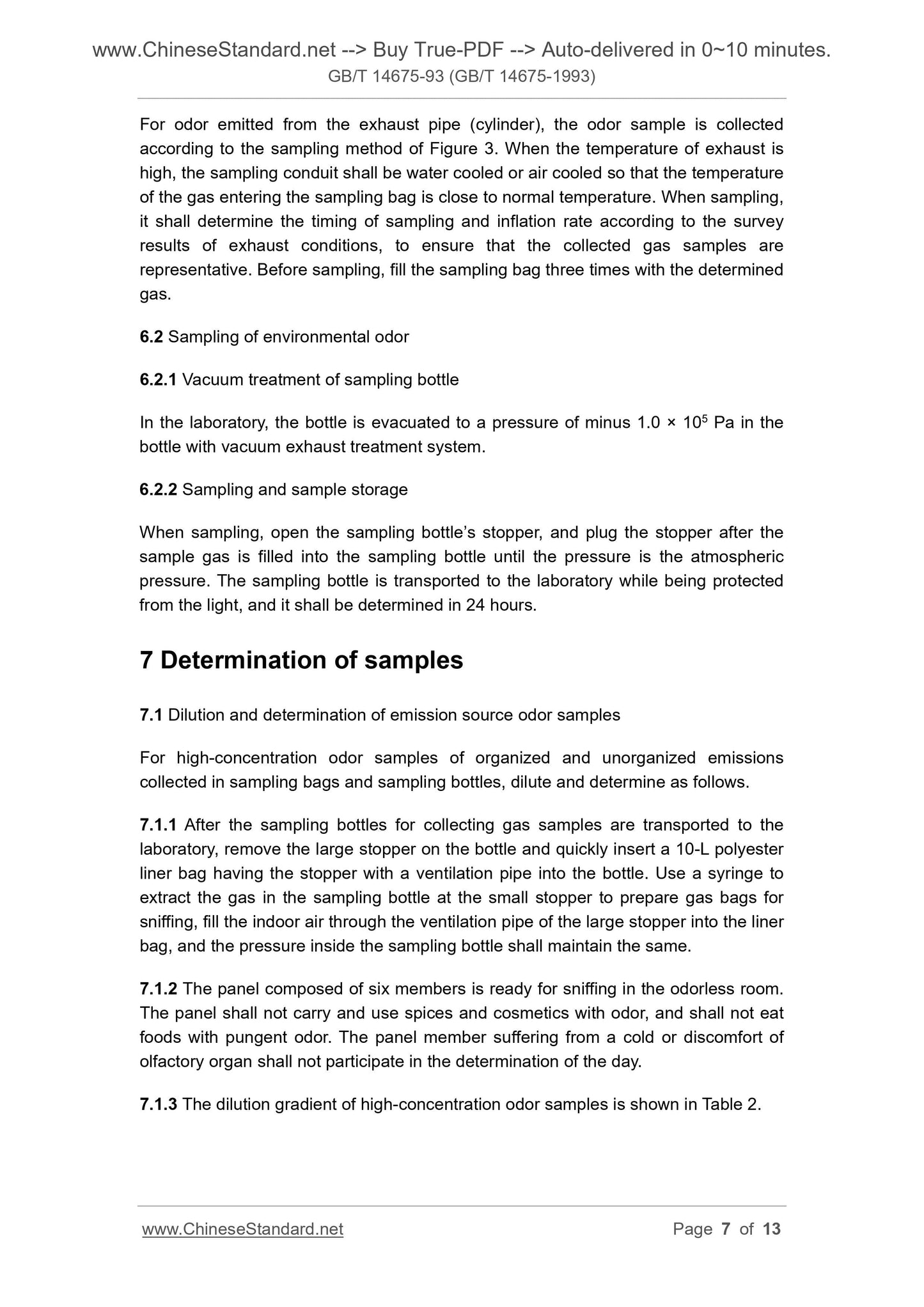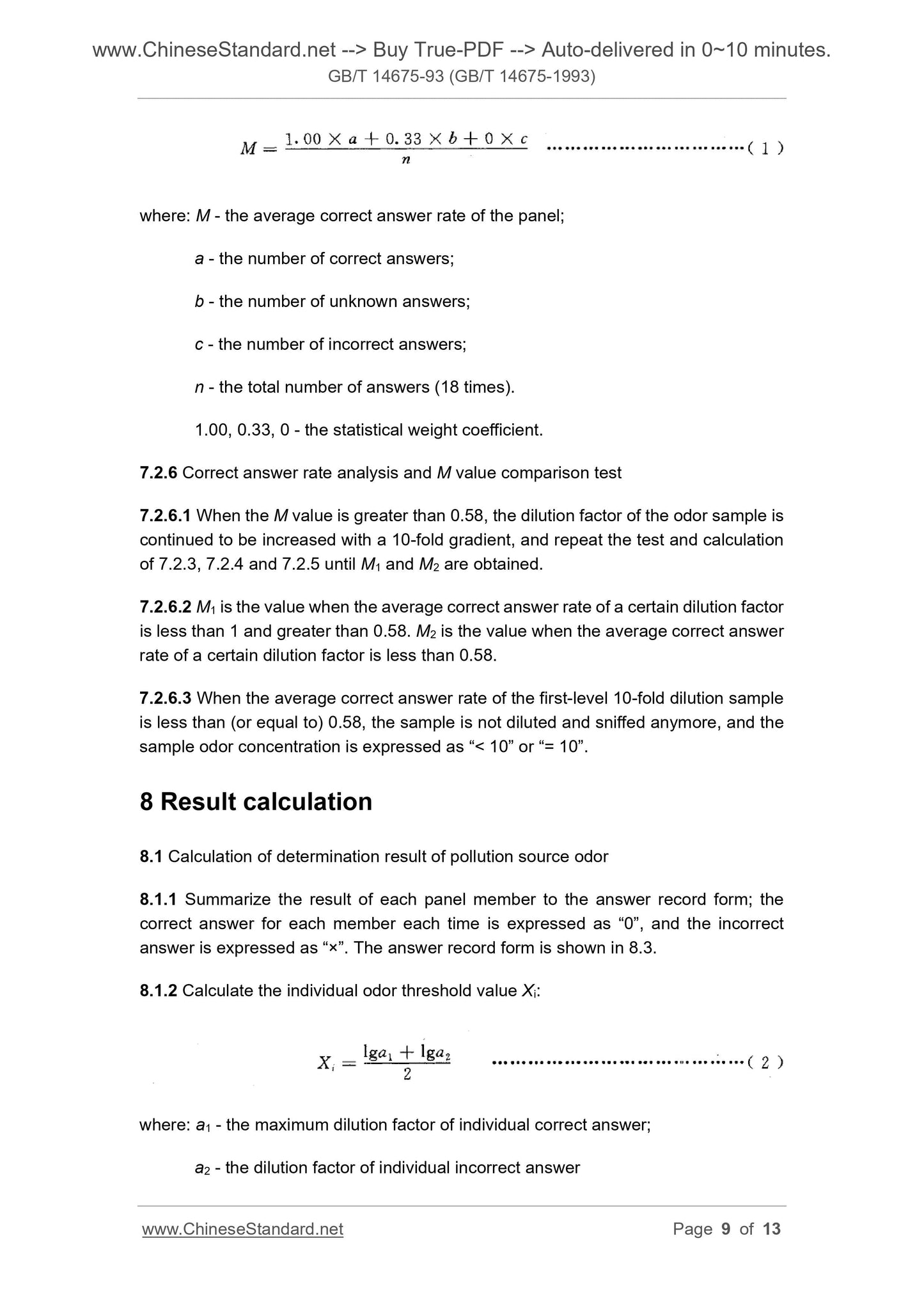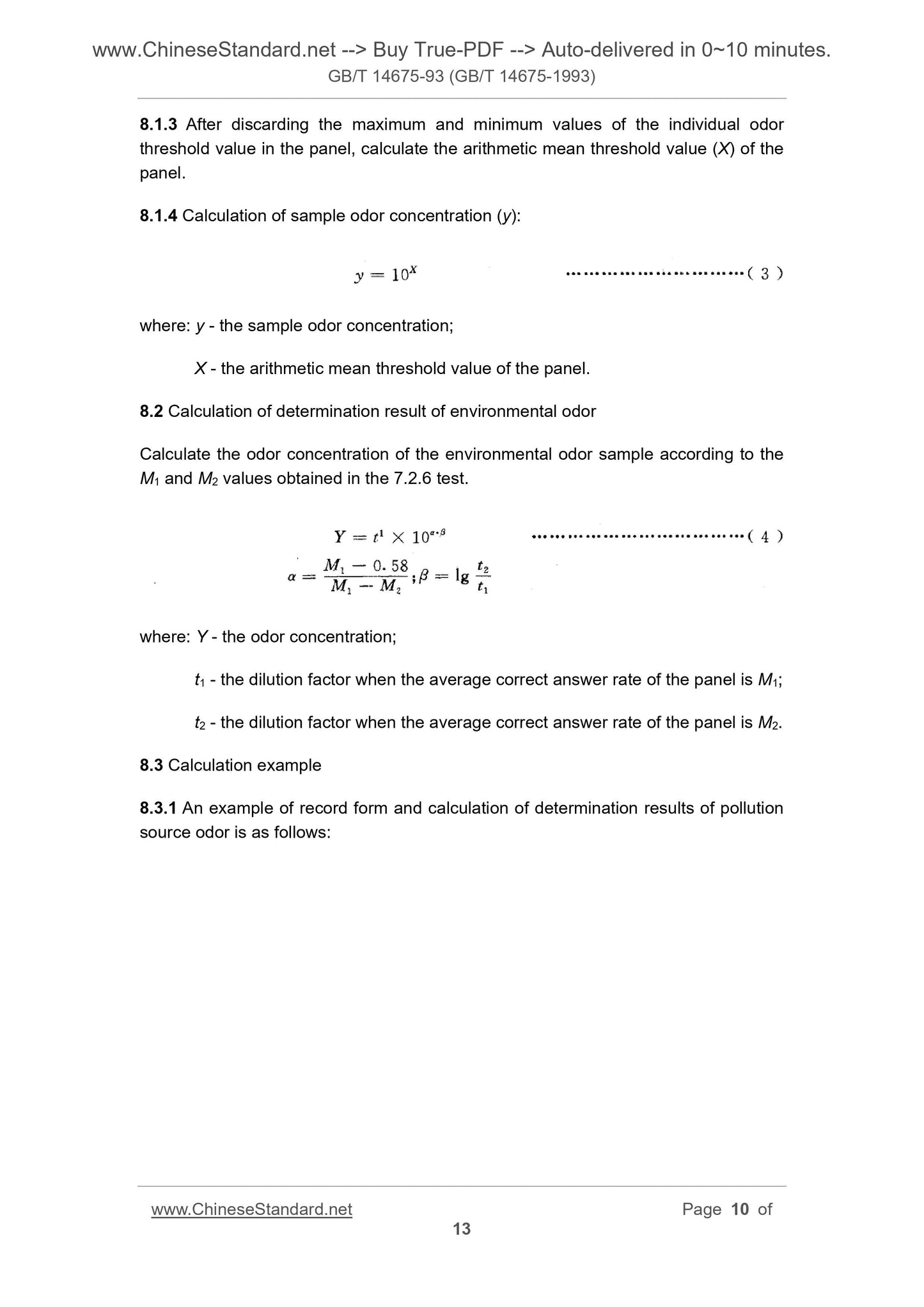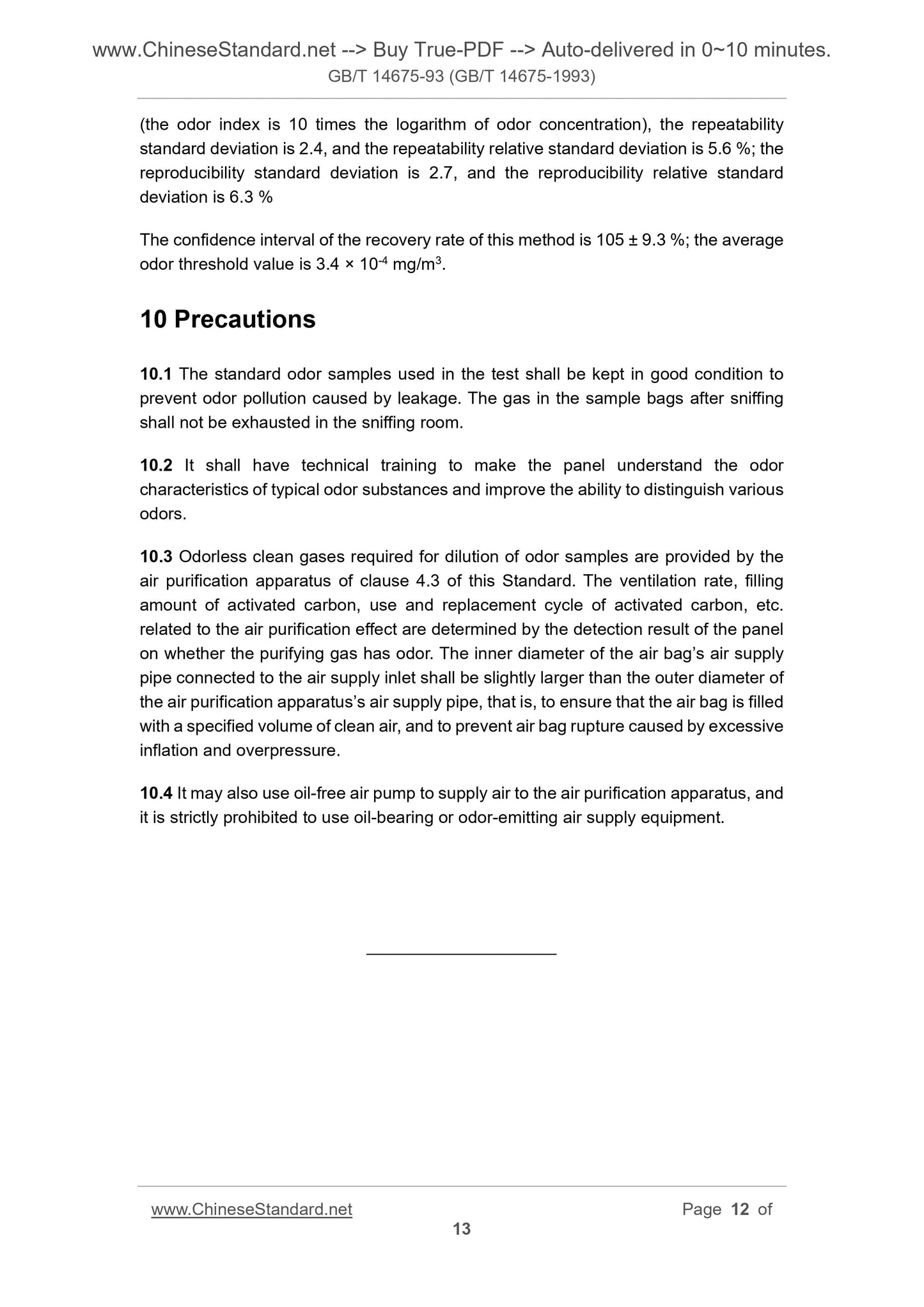1
/
of
8
PayPal, credit cards. Download editable-PDF and invoice in 1 second!
GB/T 14675-1993 English PDF (GBT14675-1993)
GB/T 14675-1993 English PDF (GBT14675-1993)
Regular price
$90.00 USD
Regular price
Sale price
$90.00 USD
Unit price
/
per
Shipping calculated at checkout.
Couldn't load pickup availability
Delivery: 3 seconds. Download true-PDF + Invoice.
Get QUOTATION in 1-minute: Click GB/T 14675-1993
Historical versions: GB/T 14675-1993
Preview True-PDF (Reload/Scroll if blank)
GB/T 14675-1993: Air quality. Determination of odor. Triangle odor bag method
GB/T 14675-93 (GB/T 14675-1993)
GB
NATIONAL STANDARD OF THE
PEOPLE’S REPUBLIC OF CHINA
UDC 614.718. 543.92
Z 15
GB/T 14675-93
Air quality - Determination of odor -
Triangle odor bag method
ISSUED ON. OCTOBER 27, 1993
IMPLEMENTED ON. MARCH 15, 1994
Issued by. State Bureau of Environmental Protection; State Bureau of
Technical Supervision.
3. No action is required - Full-copy of this standard will be automatically and
immediately delivered to your EMAIL address in 0~60 minutes.
Table of Contents
1 Subject content and scope of application ... 3
2 Terms ... 3
3 Principle ... 4
4 Reagents, materials and apparatus ... 4
5 Panel ... 6
6 Samples ... 6
7 Determination of samples ... 7
8 Result calculation ... 9
9 Precision and accuracy ... 11
10 Precautions ... 12
Additional information... 13
Air quality - Determination of odor –
Triangle odor bag method
GB/T 14675-93
1 Subject content and scope of application
1.1 This Standard specifies the determination method for the odor concentration of
odor source exhaust and ambient air samples by human olfactory organ.
1.2 This Standard applies to the determination of the odor concentration of gas
samples emitted in different forms from all kinds of odor sources and ambient air
samples. The samples include samples containing only one odor substance and
complex odor samples containing two or more odor substances.
1.3 The determination method in this Standard is not restricted by species, number of
species, concentration range and proportion of ingredients contained of odor
substances.
2 Terms
2.1 Odor concentration
Odor concentration is the indicator of quantified size of odor determined by olfactory
organ test method. The dilution factor, applied when the odor sample is diluted with
odorless clean air to panel’s threshold value, is called odor concentration.
2.2 Odor threshold value
Odor threshold value includes the sensory threshold value that can be used to sniff the
presence of odor and the identification threshold value that can determine the odor
characteristics. What used in this Standard is sensory threshold value.
2.3 Panel
Those who are qualified after being selected through special exam and trained, taken
as the panel required for the determination by the method in this Standard.
Figure 3 -- Exhaust sampling apparatus
A - vacuum box; B - sampling bag; C - gas pump; D - sample gas conduit; E - valve
4.7 Sniffing room.
4.7.1 The sniffing room shall be away from the place where emits odor. The indoor
shall be able to be ventilated and the temperature is kept at 17 ~ 25 °C. It shall be able
to contain at least 6 ~ 7 panel members at the same time.
4.7.2 It shall set up a separate gas preparation room.
4.8 Syringes. 100 mL, 50 mL, 10 mL, 5 mL, l mL and 100 μL.
5 Panel
5.1 Panel
The panel member shall be 18 ~ 45-year-old male or female, no smoking and without
olfactory organ disease, passing the olfactory detection. If no special circumstances,
they can undertake panel work for three consecutive years.
5.2 Olfactory detection and panel selection
The olfactory detection must be carried out in the sniffing room. The examiner
immerses one end of the three pieces of odorless paper among five pieces of odorless
paper into 1 cm of the odorless liquid, and immerses the other two pieces of odorless
paper into 1 cm of one kind of standard odor liquid, and then places the five pieces of
paper in parallel at a distance from each other. If the people under examination can
correctly identify the paper with odor liquid, exam them using another four kinds of
standard odor liquids according to the above method. People who can identify the
paper with five kinds of odor liquids can be the member of the panel.
6 Samples
6.1 Collection of odor samples in exhaust cylinder
For odor emitted from the exhaust pipe (cylinder), the odor sample is collected
according to the sampling method of Figure 3. When the temperature of exhaust is
high, the sampling conduit shall be water cooled or air cooled so that the temperature
of the gas entering the sampling bag is close to normal temperature. When sampling,
it shall determine the timing of sampling and inflation rate according to the survey
results of exhaust conditions, to ensure that the collected gas samples are
representative. Before sampling, fill the sampling bag three times with the determined
gas.
6.2 Sampling of environmental odor
6.2.1 Vacuum treatment of sampling bottle
In the laboratory, the bottle is evacuated to a pressure of minus 1.0 × 105 Pa in the
bottle with vacuum exhaust treatment system.
6.2.2 Sampling and sample storage
When sampling, open the sampling bottle’s stopper, and plug the stopper after the
sample gas is filled into the sampling bottle until the pressure is the atmospheric
pressure. The sampling bottle is transported to the laboratory while being protected
from the light, and it shall be determined in 24 hours.
7 Determination of samples
7.1 Dilution and determination of emission source odor samples
For high-concentration odor samples of organized and unorganized emissions
collected in sampling bags and sampling bottles, dilute and determine as follows.
7.1.1 After the sampling bottles for collecting gas samples are transported to the
laboratory, remove the large stopper on the bottle and quickly insert a 10-L polyester
liner bag having the stopper with a ventilation pipe into the bottle. Use a syringe to
extract the gas in the sampling bottle at the small stopper to prepare gas bags for
sniffing, fill the indoor air through the ventilation pipe of the large stopper into the liner
bag, and the pressure inside the sampling bottle shall maintain the same.
7.1.2 The panel composed of six members is ready for sniffing in the odorless room.
The panel shall not carry and use spices and cosmetics with odor, and shall not eat
foods with pungent odor. The panel member suffering from a cold or discomfort of
olfactory organ shall not participate in the determination of the day.
7.1.3 The dilution gradient of high-concentration odor samples is shown in Table 2.
where. M - the average correct answer rate of the panel;
a - the number of correct answers;
b - the number of unknown answers;
c - the number of incorrect answers;
n - the total number of answers (18 times).
1.00, 0.33, 0 - the statistical weight coefficient.
7.2.6 Correct answer rate analysis and M value comparison test
7.2.6.1 When the M value is greater than 0.58, the dilution factor of the odor sample is
continued to be increased with a 10-fold gradient, and repeat the test and calculation
of 7.2.3, 7.2.4 and 7.2.5 until M1 and M2 are obtained.
7.2.6.2 M1 is the value when the average correct answer rate of a certain dilution factor
is less than 1 and greater than 0.58. M2 is the value when the average correct answer
rate of a certain dilution factor is less than 0.58.
7.2.6.3 When the average correct answer rate of the first-level 10-fold dilution sample
is less than (or equal to) 0.58, the sample is not diluted and sniffed anymore, and the
sample odor concentration is expressed as “< 10” or “= 10”.
8 Result calculation
8.1 Calculation of determination result of pollution source odor
8.1.1 Summarize the result of each panel member to the answer record form; the
correct answer for each member each time is expressed as “0”, and the incorrect
answer is expressed as “×”. The answer record...
Get QUOTATION in 1-minute: Click GB/T 14675-1993
Historical versions: GB/T 14675-1993
Preview True-PDF (Reload/Scroll if blank)
GB/T 14675-1993: Air quality. Determination of odor. Triangle odor bag method
GB/T 14675-93 (GB/T 14675-1993)
GB
NATIONAL STANDARD OF THE
PEOPLE’S REPUBLIC OF CHINA
UDC 614.718. 543.92
Z 15
GB/T 14675-93
Air quality - Determination of odor -
Triangle odor bag method
ISSUED ON. OCTOBER 27, 1993
IMPLEMENTED ON. MARCH 15, 1994
Issued by. State Bureau of Environmental Protection; State Bureau of
Technical Supervision.
3. No action is required - Full-copy of this standard will be automatically and
immediately delivered to your EMAIL address in 0~60 minutes.
Table of Contents
1 Subject content and scope of application ... 3
2 Terms ... 3
3 Principle ... 4
4 Reagents, materials and apparatus ... 4
5 Panel ... 6
6 Samples ... 6
7 Determination of samples ... 7
8 Result calculation ... 9
9 Precision and accuracy ... 11
10 Precautions ... 12
Additional information... 13
Air quality - Determination of odor –
Triangle odor bag method
GB/T 14675-93
1 Subject content and scope of application
1.1 This Standard specifies the determination method for the odor concentration of
odor source exhaust and ambient air samples by human olfactory organ.
1.2 This Standard applies to the determination of the odor concentration of gas
samples emitted in different forms from all kinds of odor sources and ambient air
samples. The samples include samples containing only one odor substance and
complex odor samples containing two or more odor substances.
1.3 The determination method in this Standard is not restricted by species, number of
species, concentration range and proportion of ingredients contained of odor
substances.
2 Terms
2.1 Odor concentration
Odor concentration is the indicator of quantified size of odor determined by olfactory
organ test method. The dilution factor, applied when the odor sample is diluted with
odorless clean air to panel’s threshold value, is called odor concentration.
2.2 Odor threshold value
Odor threshold value includes the sensory threshold value that can be used to sniff the
presence of odor and the identification threshold value that can determine the odor
characteristics. What used in this Standard is sensory threshold value.
2.3 Panel
Those who are qualified after being selected through special exam and trained, taken
as the panel required for the determination by the method in this Standard.
Figure 3 -- Exhaust sampling apparatus
A - vacuum box; B - sampling bag; C - gas pump; D - sample gas conduit; E - valve
4.7 Sniffing room.
4.7.1 The sniffing room shall be away from the place where emits odor. The indoor
shall be able to be ventilated and the temperature is kept at 17 ~ 25 °C. It shall be able
to contain at least 6 ~ 7 panel members at the same time.
4.7.2 It shall set up a separate gas preparation room.
4.8 Syringes. 100 mL, 50 mL, 10 mL, 5 mL, l mL and 100 μL.
5 Panel
5.1 Panel
The panel member shall be 18 ~ 45-year-old male or female, no smoking and without
olfactory organ disease, passing the olfactory detection. If no special circumstances,
they can undertake panel work for three consecutive years.
5.2 Olfactory detection and panel selection
The olfactory detection must be carried out in the sniffing room. The examiner
immerses one end of the three pieces of odorless paper among five pieces of odorless
paper into 1 cm of the odorless liquid, and immerses the other two pieces of odorless
paper into 1 cm of one kind of standard odor liquid, and then places the five pieces of
paper in parallel at a distance from each other. If the people under examination can
correctly identify the paper with odor liquid, exam them using another four kinds of
standard odor liquids according to the above method. People who can identify the
paper with five kinds of odor liquids can be the member of the panel.
6 Samples
6.1 Collection of odor samples in exhaust cylinder
For odor emitted from the exhaust pipe (cylinder), the odor sample is collected
according to the sampling method of Figure 3. When the temperature of exhaust is
high, the sampling conduit shall be water cooled or air cooled so that the temperature
of the gas entering the sampling bag is close to normal temperature. When sampling,
it shall determine the timing of sampling and inflation rate according to the survey
results of exhaust conditions, to ensure that the collected gas samples are
representative. Before sampling, fill the sampling bag three times with the determined
gas.
6.2 Sampling of environmental odor
6.2.1 Vacuum treatment of sampling bottle
In the laboratory, the bottle is evacuated to a pressure of minus 1.0 × 105 Pa in the
bottle with vacuum exhaust treatment system.
6.2.2 Sampling and sample storage
When sampling, open the sampling bottle’s stopper, and plug the stopper after the
sample gas is filled into the sampling bottle until the pressure is the atmospheric
pressure. The sampling bottle is transported to the laboratory while being protected
from the light, and it shall be determined in 24 hours.
7 Determination of samples
7.1 Dilution and determination of emission source odor samples
For high-concentration odor samples of organized and unorganized emissions
collected in sampling bags and sampling bottles, dilute and determine as follows.
7.1.1 After the sampling bottles for collecting gas samples are transported to the
laboratory, remove the large stopper on the bottle and quickly insert a 10-L polyester
liner bag having the stopper with a ventilation pipe into the bottle. Use a syringe to
extract the gas in the sampling bottle at the small stopper to prepare gas bags for
sniffing, fill the indoor air through the ventilation pipe of the large stopper into the liner
bag, and the pressure inside the sampling bottle shall maintain the same.
7.1.2 The panel composed of six members is ready for sniffing in the odorless room.
The panel shall not carry and use spices and cosmetics with odor, and shall not eat
foods with pungent odor. The panel member suffering from a cold or discomfort of
olfactory organ shall not participate in the determination of the day.
7.1.3 The dilution gradient of high-concentration odor samples is shown in Table 2.
where. M - the average correct answer rate of the panel;
a - the number of correct answers;
b - the number of unknown answers;
c - the number of incorrect answers;
n - the total number of answers (18 times).
1.00, 0.33, 0 - the statistical weight coefficient.
7.2.6 Correct answer rate analysis and M value comparison test
7.2.6.1 When the M value is greater than 0.58, the dilution factor of the odor sample is
continued to be increased with a 10-fold gradient, and repeat the test and calculation
of 7.2.3, 7.2.4 and 7.2.5 until M1 and M2 are obtained.
7.2.6.2 M1 is the value when the average correct answer rate of a certain dilution factor
is less than 1 and greater than 0.58. M2 is the value when the average correct answer
rate of a certain dilution factor is less than 0.58.
7.2.6.3 When the average correct answer rate of the first-level 10-fold dilution sample
is less than (or equal to) 0.58, the sample is not diluted and sniffed anymore, and the
sample odor concentration is expressed as “< 10” or “= 10”.
8 Result calculation
8.1 Calculation of determination result of pollution source odor
8.1.1 Summarize the result of each panel member to the answer record form; the
correct answer for each member each time is expressed as “0”, and the incorrect
answer is expressed as “×”. The answer record...
Share
